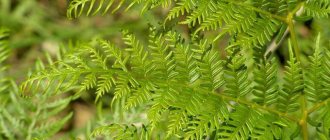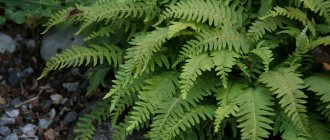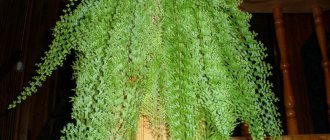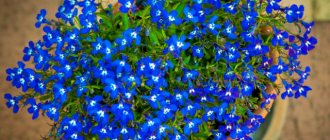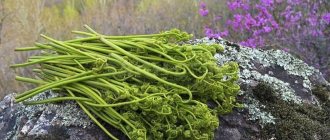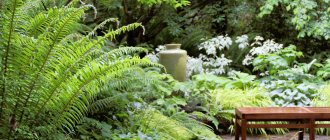Osmunda regalis, also known as royal osmunda, is one of the most impressive fern species. In nature, it can grow into large colonies along ponds, rivers and streams. It usually grows to 60-90 cm in height, but in conditions of constant humidity the height can reach one and a half meters.
The plant forms a tall and dense crown of shiny, feathery leaves that change color as they grow - at the beginning of the growing season they have a slight reddish tint, are bright green in summer, and become golden in autumn.
In early June, brown cyst-like sporangia form at the end of each leaf branch, giving the osmunda an unusual flowering appearance. In 1993, the Royal Horticultural Society received the Royal Horticultural Society's Award of Merit in the Garden for its popularity in landscape design.
Osmunda is one of the few "living fossils" in the faunal world. Paleontological finds indicate that the plant grew on Earth about 180 million years ago and remained virtually unchanged during this entire period.
Kinds
In the open ground of the middle zone, three types of chistost are most often grown: royal, Asian and Clayton.
Royal
Osmunda royal or majestic grows in vast European territories, in the Caucasus, in the forests of both Americas, India, Africa, in swamps and peat bogs. In the south, with sufficient humidity, this species reaches a height of two meters. The leaves (in fact, of course, these are not really leaves; botanists call them flat branches, fronds) are dense, leathery, with a pinnate structure characteristic of ferns.
They die off in the winter, and in the spring they grow again with reddish shoots, then, as they develop, they become light green and in the autumn, towards the end of the growing season, they acquire a pure golden color.
The upper segments of some leaves are completely covered with spore-bearing parts and become like panicles.
After the spores disperse, they acquire a brownish-red color and clearly stand out against the general light green background.
Photo of the subspecies Chistoust majestic:
Asiatic
Osmunda asiatica or cinnamon grows in eastern North America, as well as in the Far Eastern region, in damp forest glades.
It has shiny light green leaves, and red shoots covered with fern spores appear in June, clustered in the center of the bush.
Deciduous bloom lasts from May to September; by the end of this period, it acquires an orange color, creating “flaming” thickets in places of mass growth.
Photo of the Asian Chistoust subspecies:
Clayton
Osmunda Clayton is found less frequently on damp edges and in light ravines of North American, Chinese, Japanese and Himalayan forests.
Occasionally it grows in the south of the Primorsky Territory - there it is protected as a relict plant.
It has light green feathery leaves with a waxy coating and, like the Asian species of osmunda, it also grows spores on the central shoots of the bush in summer, but the spore-bearing parts do not cover the entire leaf, but are located only on its middle parts.
By mid-autumn the leaves are orange-gold in September.
Photo of the subspecies Clayton's Chistoust:
Weekend recipe: how to prepare and how to cook fern
The end of May - beginning of June is the traditional time for fern harvesting on Sakhalin. Young shoots of bracken and osmund are collected. The first one is more “bald”, the second one is shaggy and grows in a bunch. Vera Pyak told readers of SakhalinMedia news agency how to prepare them and how to cook them.
Ferns need to be harvested before they have opened. Young shoots are edible while they are fragile. Therefore, they are not torn off, but broken. You can still tear off the top curl of future leaves from the bracken, or you don’t have to tear it off.
Home care
Lighting Purple ferns, native forest dwellers, prefer shady and semi-shaded places. However, if you provide them with constant humidity, they will tolerate lighted areas.
Temperature
The Osmunda genus primarily grows in warm and temperate climates.
Royal osmunda is less resistant to frost. The Asian (cinnamon) species and Clayton's cleanmouth can withstand forty-degree frosts.
Shelter for the winter
The royal (majestic) cleanmouth will successfully withstand the winter cold if it is covered with fallen leaves of oak, maple or linden.
Birch foliage and pine needles are not used for such shelter.
The Asian chistoust does not need shelter, just like the Clayton's chistoust.
Other winter-hardy ferns suitable for growing in the garden or on a personal plot include: Ostrich, Kochedydnik, Bracken, Bladderwort, Adiantum, Polygonum, Shield fern
Humidity
High humidity is a prerequisite for the development of ferns, especially forest forms, which include thyme. If there is little moisture in the soil, growth slows down and potentially one and a half to two meter giants become short dwarfs.
Only a well-developed, tall fern can be drought-resistant - for a limited time.
Abundant watering and planting near a reservoir allows osmunda to grow in an open, illuminated place.
The soil
Celandine, like all ferns, grows on loose, acidic soils.
The optimal soil for planting them should contain peat, rotted leaves, pine needles and sand.
Feeding is not required, and humus, especially manure, can lead to the death of these plants.
Transfer
Transplantation and parallel rejuvenating division are best done in early spring, when the osmunda begins to grow.
Plants, or their separated parts, are planted in places with prepared soil while preserving the earthen clod as much as possible.
During the period of active growth, in the summer, transplantation is also possible. In this case, in addition to preserving the roots, it is necessary to ensure high soil moisture.
Transplanted ferns restore and grow their root system within a year or two. At this time they are highly hygrophilous.
Trimming
The leaves (fronds) of the osmund are pruned when dividing the bush in the summer. Pruning before winter is recommended only for cinnamon osmunda.
Reproduction
Reproduction of chistousts by spores is possible, but it practically occurs by self-seeding, since the viability of the spores remains for a short time - no longer than two weeks. The shoots sown by the fern itself can be carefully planted, and the distance between the young plants should be at least one and a half meters
For the targeted propagation of chistousts in landscape culture, rhizome division is used. At the same time, trying not to destroy the earthen ball, separate the side shoots with a piece of the root system and plant them in a prepared place with appropriate soil.
This operation works best in the spring, when young leaves are just unfurling.
During summer division, fern leaves should be cut off and increased watering of the planted parts should be provided, especially since the divisions take root quite difficult, and the growth of rooted specimens occurs slowly, over one to two years.
Beneficial features
In the process of growth and development, chistoustas - ferns with a powerful root system - form around themselves a soil layer of a specific composition, which is used as a substrate for growing orchids.
At the same time, “osmund peat” from under the royal (majestic) chistoust is especially valued.
Hairs of the same type of osmund, mixed with cotton, were used in Japanese weaving to make coarse fabric.
Cinnamomum cinnamon (Asian) is one of the edible ferns. People eat rachis - the stem of a young shoot with a leaf that has not yet unfurled. These parts are salted or boiled immediately after collection, and then used as a healthy flavoring agent in mixed dishes.
Experienced herbalists use decoctions of the leaves and rhizomes of the cinnamon plant externally - as a wound-healing and antirheumatic agent, as well as for oral administration for a whole range of problems, including diseases of the spleen and intestines.
An overdose of fern preparations is extremely dangerous, so they are used very carefully and consciously.
Osmunda (cleanmouth) grows moderately; such a plant will never become a weed.
This fern not only has a long million-year-old pedigree, supplies substrate for orchids, medicinal potions and exotic flavoring additives, but is also a persistent, unpretentious, spectacular decoration of the site, especially in damp and shady places where most decorative foliage plants do not survive.
Ferns came to us from the era of dinosaurs. True, at that time it was huge in size and crushed a little in our time. However, fern is actively used for landscape design. You will find detailed information on caring for the varieties of ferns Asplenium, Polypodium, Nephrolepis, Shield, Davallia, Kochedyzhnik, Ostrich, Grozdovnik, Uzhovnik and Cyrthomium on our website.
How I cook fern
Good afternoon Wild ferns grow on Sakhalin and can be eaten. It makes a delicious spicy salad. I'll tell you how I prepare it))
It needs to be harvested at the end of May - beginning of June, when its leaves have not yet begun to bloom. He looks like this at this time
We break off the stem 3-4 cm from the ground so that the stem above is juicy and not ossified. At home, I also break off a couple of centimeters from the stem and tear off the head with a bud of leaves, although some people also cook with buds.
I throw the fern into boiling water and when the water boils, I cook it for 5-7 minutes
And now we lay out the fern to dry. It is better to dry in a ventilated place, not under the scorching sun. I dried it on the balcony on a mosquito net covered with oilcloth))
We move the fern more often. The fern should be completely dry. It will ossify, turn brown and greatly decrease in size.
That's it - our preparation is ready)) We collect it in a bag and store it for as long as necessary.
Now, when you want to cook it for food, soak the dry fern in cold or warm water and soak for a day or two, periodically changing the water so that the fern swells and the bitterness goes away
Then boil until soft for about 10 minutes, drain the water. Fry onions and carrots in vegetable oil in a frying pan. Then add the fern to the frying pan and fry for 5 minutes. And add spices: soy sauce, ground red pepper, crushed garlic, adinamodo or sugar, sesame seeds. Stir and simmer for another 5 minutes under the lid. That's it, the fern is ready!
